
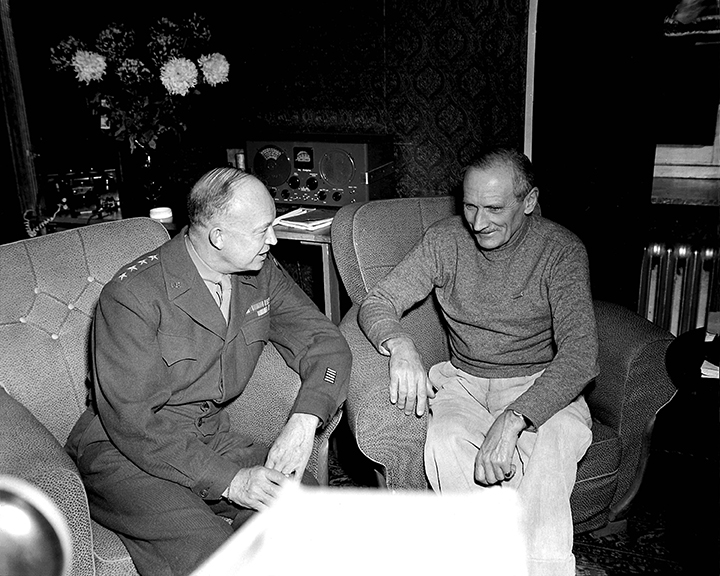
General Eisenhower confers with French generals French 1st Army Corps Headquarters November 25, 1944 Ranking allied leaders look over a situation map outside of French 1st Army Corps Headquarters. Left to right, French 5-star General De Lattre De Tassigny, commander 1st French Army; U.S. Lieutenant General Omar Bradley, commander, 12th Army Group; French 4-star General Marie Emile Bethouart, commander 1st French Army Corps; U.S. Lieutenant General Jacob L. Devers, commander, 6th Army Group; and General Dwight Eisenhower, Supreme Allied Commander.
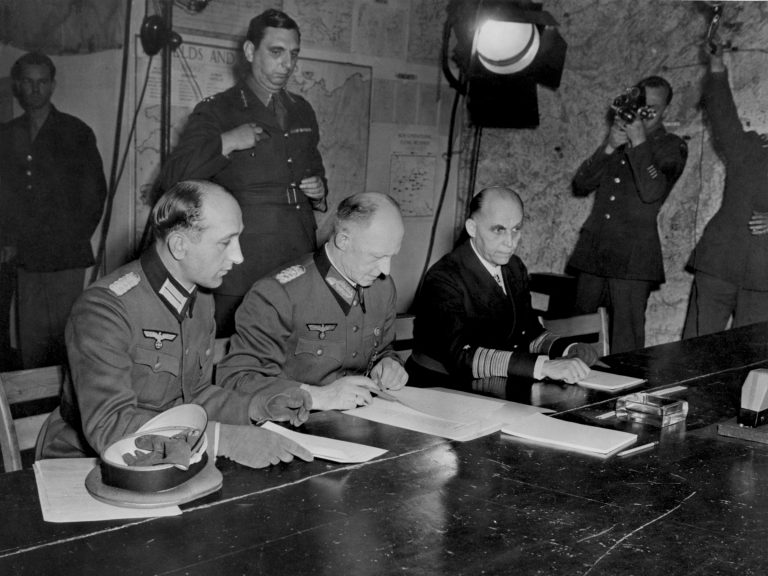
Colonel General Jodl reviews the surrender document War Room Supreme Headquarters Allied Expeditionary Force Forward Rheims, France May 7, 1945 (0230 hours) Having acknowledged that Germany will surrender, German Colonel General Alfred Jodl, Chief of Staff, German Army, reviews the surrender document. Seated to his right is his aide Major Wilhelm Oxenius and to his left is Admiral Hans Georg von Friedeburg, Commander in Chief, German Navy. Standing behind Jodl is British Major General Harold R. “Pinky” Bull, SHAEF G3 (Operations), who acted as an observer. U.S. Army cameraman Jack Howell is seen filming the ceremony, right rear.
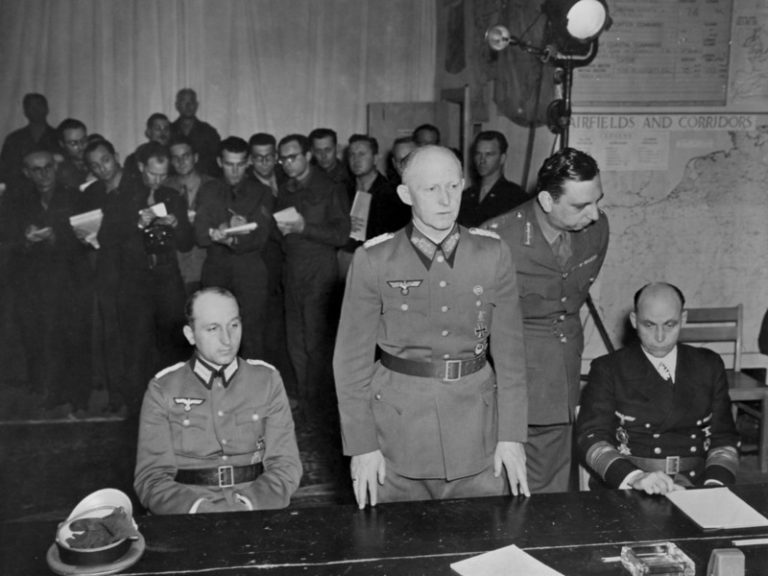
German Colonel General Jodl is asked if the unconditional surrender terms are understood. War Room Supreme Headquarters Allied Expeditionary Force Forward Rheims, France May 7, 1945 (0200 hours) German Colonel General Alfred Jodl, Chief of Staff, German Army (center) is asked by Allied representatives if the Germans understand the unconditional surrender terms and if he is prepared to sign the document. General Jodl indicated “yes” with a slight nod. Seated on General Jodl’s right is his aide, Major G. C. Wilhelm Oxenius. On his left, standing, is British Major General Harold R. “Pinky” Bull, Supreme Headquarters Allied Expeditionary Force G3 (Operations) and, seated, Admiral Hans Georg von Friedeburg, Commander in Chief of the German Navy. Standing behind the German delegation are correspondents of the Allied press.
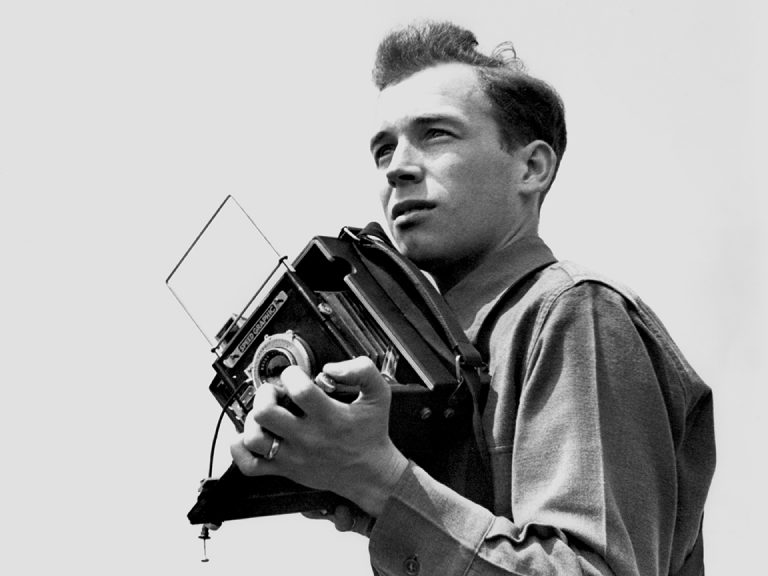
Al Meserlin

U.S. soldiers, celebrating victory, pull down the swastika flag of Nazi Germany Rheims, France May 1945 U.S. troops haul down the flag of Nazi Germany outside a bank in Rheims, France. The war in Europe was over!
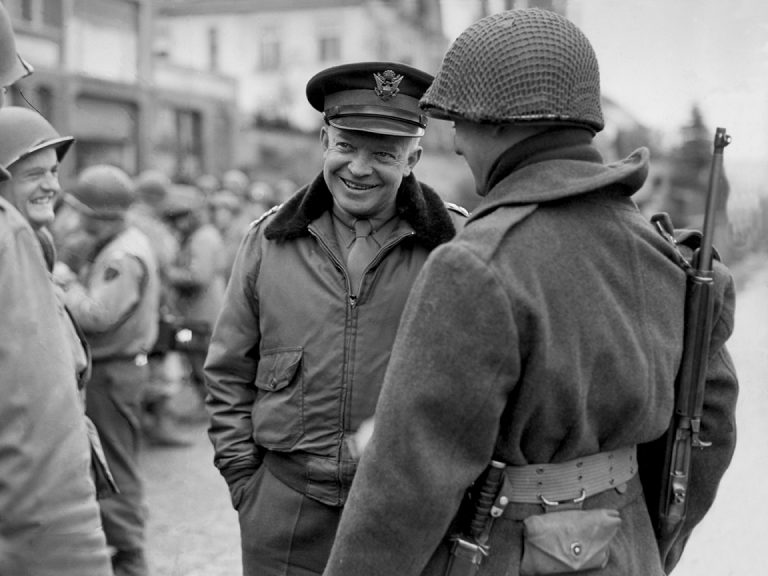
Visiting the troops - Belgium November 9, 1944 Private First Class (PFC) Richard W. Rife of Richmond, Indiana, right, talks with General Eisenhower during the General’s visit to the PFC’s division command post in Belgium. Visiting the troops was Ike’s favorite activity.
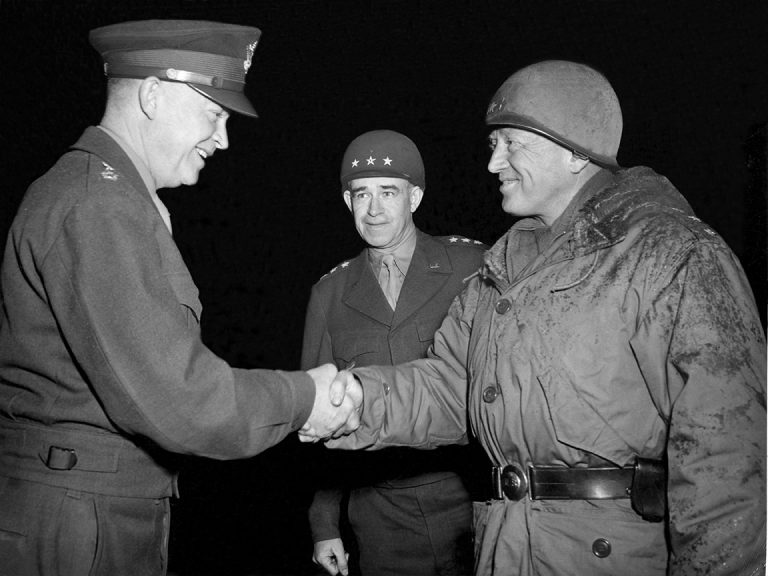
Ike shakes the hand of Lieutenant General George Patton with General Omar Bradley watching - Bastogne, Belgium February 5, 1945 Supreme Allied Commander Dwight Eisenhower shakes hands with U.S. Lieutenant General George S. Patton, commander, U.S. Third Army, on February 5, 1945 in Bastogne, Belgium. Elements of Patton’s Third Army relieved the besieged town during the Battle of the Bulge on December 26, 1944, coming to the rescue of a surrounded U.S. division, the heroic 101st Airborne Division. U.S. Lieutenant General Omar Bradley, commander, 12th Army Group, looks on. In Bastogne, Ike expressed high praise for the defense of the town.
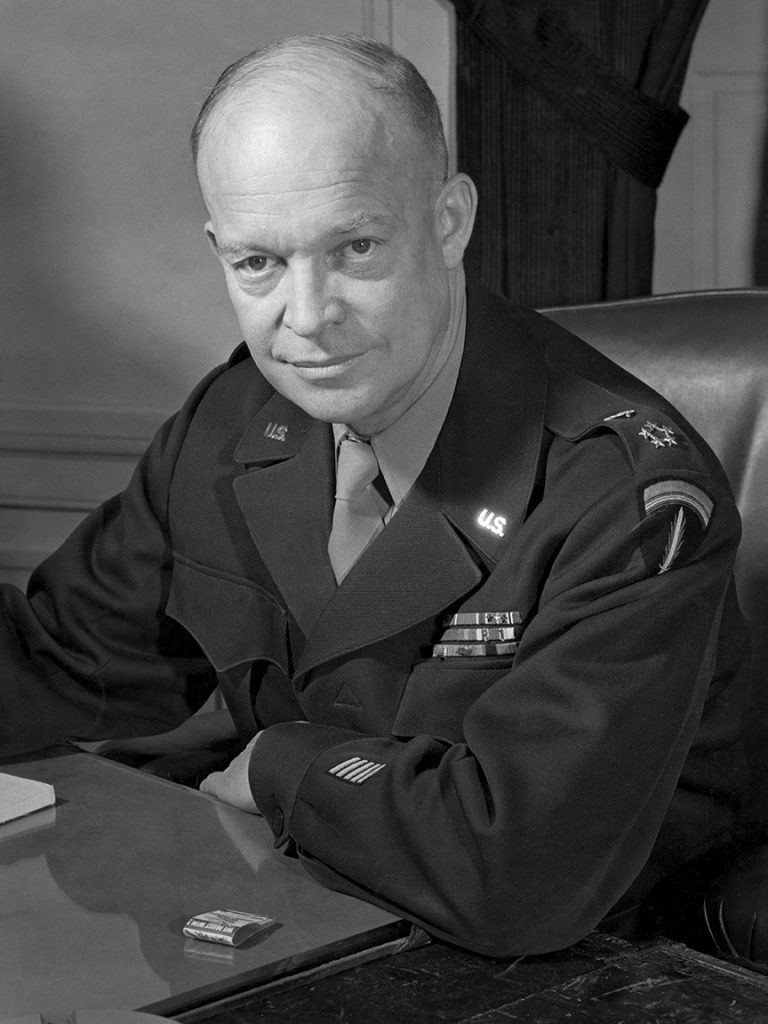
Official photo of newly promoted 5-Star General Dwight. D. Eisenhower Supreme Headquarters Allied Expeditionary Force Versailles, France February 1, 1945 Official photo of newly promoted U.S. General of the Army Dwight D. Eisenhower, Supreme Allied Commander, seen wearing his new rank, a 5-star cluster on his uniform’s shoulder strap. Later versions of the photo were altered to eliminate the matchbook on Ike’s desk.
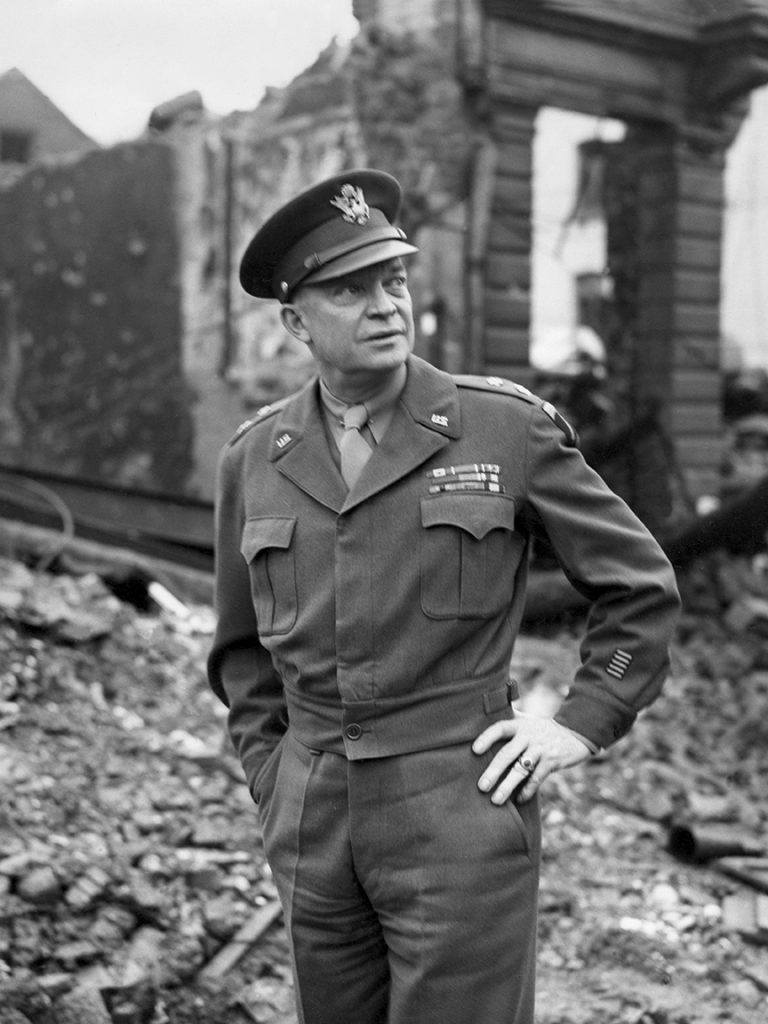
Ike surveys the battle damage at Bastogne after the Battle of the Bulge - Bastogne, Belgium February 5, 1945 General Eisenhower, Supreme Allied Commander, looks over the ruins of Bastogne, Belgium, a town surrounded by the German Army during the Battle of the Bulge, December 16, 1944 – January 31, 1945. Ike surveyed the battlefield on February 5, 1945.
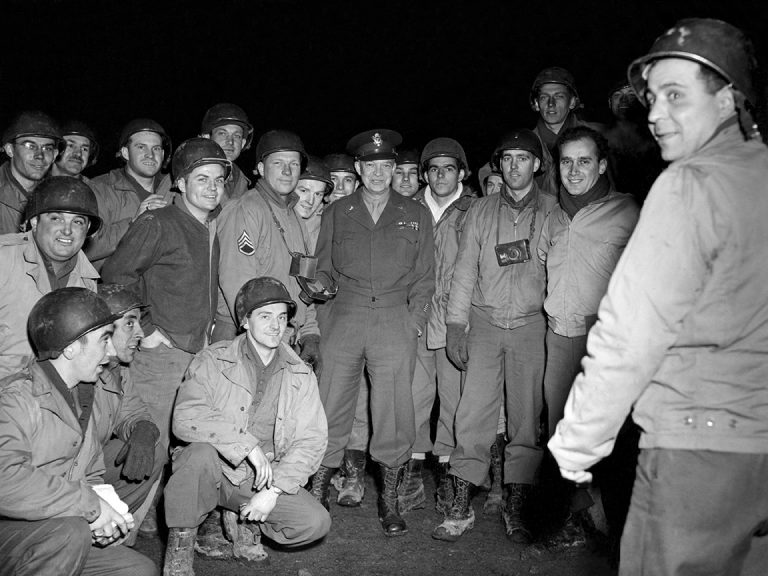
Visiting the troops - Belgium February 5, 1945 General Dwight Eisenhower poses with a group of soldiers during a visit to the Battle of the Bulge battlefield. The soldiers were members of the 334th Anti-Aircraft Artillery (AAA) Battalion. Posing with the soldiers began when one of them recognized Ike and asked to have his photo taken with him.
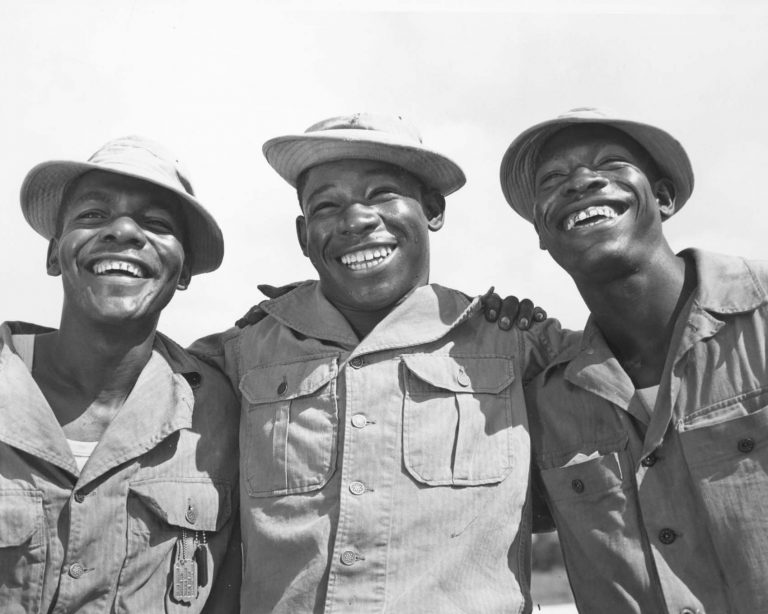
African-American soldiers on maneuver - Fort Polk, Louisiana: Summer 1943
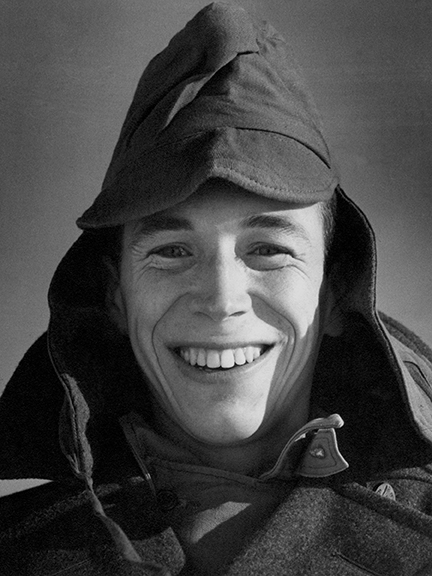
Tech Sergeant (T/5) Al Meserlin As terrible as it was, World War II had to be photographed and filmed for the world to remember what the war was all about. Assigned such a mission was the 165th Signal Photo Company. Based in England, its men were tasked to go in harm’s way to photograph the European War for posterity. This was no small task, and within this unit alone at least two members were killed performing their job and several were wounded. In France in 1944, Tech Sergeant Al Meserlin (T/5) was selected to record the war in photos from a unique vantage point. He was chosen to be the Supreme Headquarters Allied Expeditionary Force Commander Dwight D. Eisenhower’s personal photographer. From September 1944 on, Al photographed Ike conferring with Allied leaders, conferencing with his generals, directing the defeat of the Nazi Germany, and accepting the surrender of the Armed Forces of the Third Reich on May 7, 1945. Al’s photos are those most associated with the historical final phases of the war and have appeared in all the standard texts on World War II.
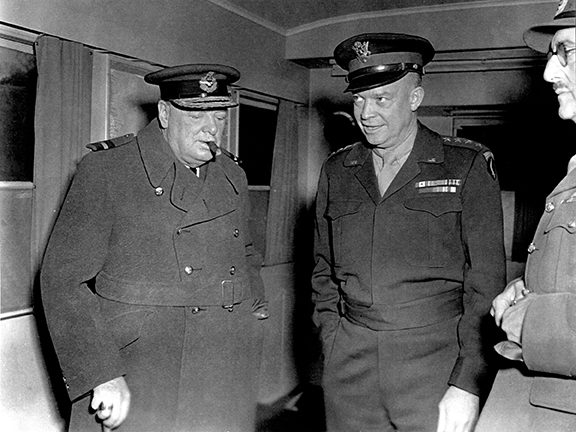
Ike showing Churchill his command trailer Rheims, France November 14, 1944 British Prime Minister Churchill and Supreme Allied Commander Dwight Eisenhower confer in Ike’s command trailer located near Rheims, France. Churchill flew back to London shortly thereafter.
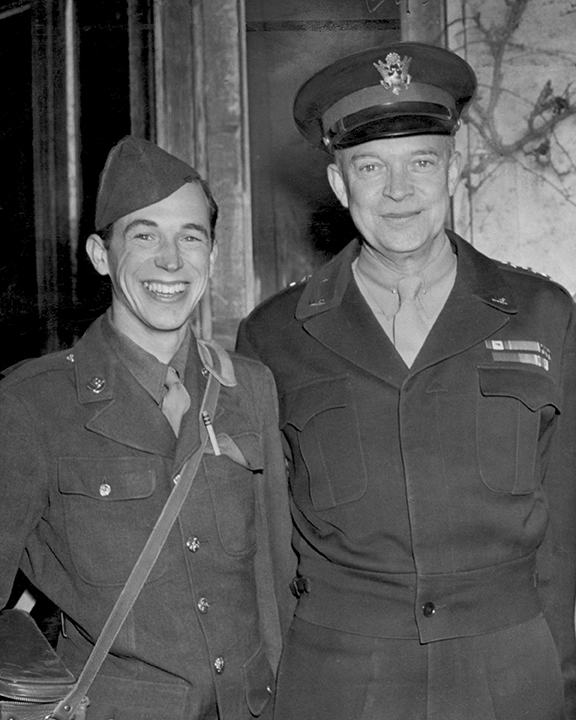
Meeting General Dwight D. Eisenhower for the first time Supreme Headquarters, Allied Expeditionary Force (SHAEF) Versailles, France September 1944 Al Meserlin with General Dwight D. Eisenhower, Commander of Allied Forces in Europe, at his headquarters in Versailles, France. Meserlin served as Eisenhower’s personal wartime photographer September 1944 to June 1945. He said of Eisenhower that the General always allowed him to photograph at will and rarely ever posed for a picture.
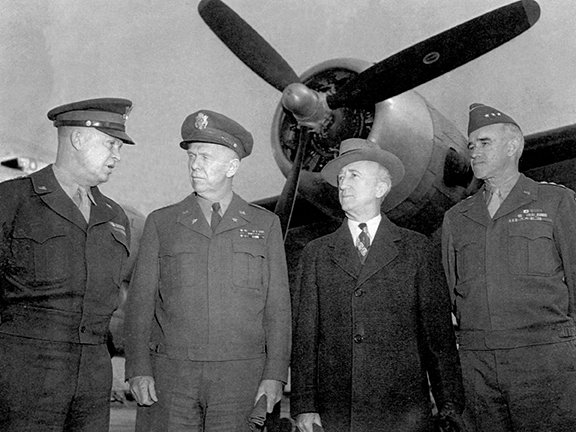
Ike meeting with General George C. Marshall, Chief of Staff, U.S. Army Orly Airport, Paris, France October 6, 1944 General Dwight Eisenhower, Supreme Allied Commander Europe, left, greets General George C. Marshall, Chief of Staff, U.S. Army, and James F. Byrnes, Director of the U.S. War Mobilization Office, upon their arrival at Orly Airport. U.S. General Omar Bradley, commander, 12th Army Group, is standing on everyone’s right. In the background is President Franklin D. Roosevelt’s plane, “The Sacred Cow.” General Marshall and Byrnes were flown directly to Paris from Newfoundland, Canada, for this high-level meeting. This was the first publicized wartime flight direct to France from North America.
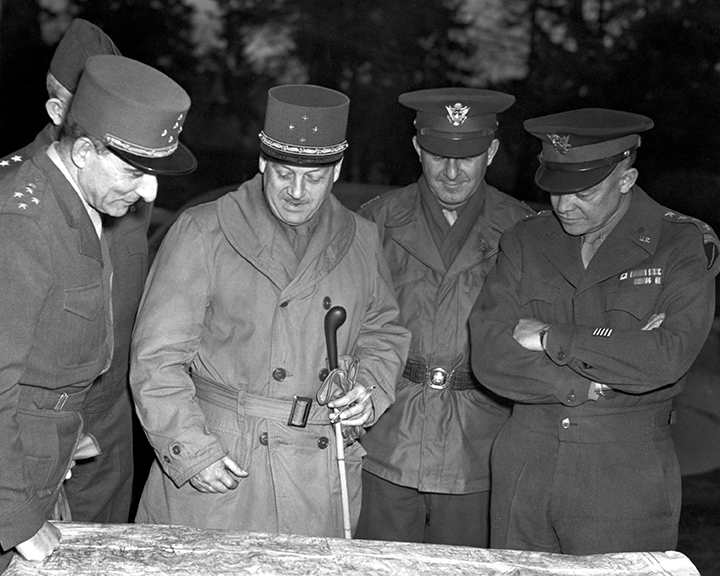
General Eisenhower confers with French generals French 1st Army Corps Headquarters November 25, 1944 Ranking allied leaders look over a situation map outside of French 1st Army Corps Headquarters. Left to right, French 5-star General De Lattre De Tassigny, commander 1st French Army; U.S. Lieutenant General Omar Bradley, commander, 12th Army Group; French 4-star General Marie Emile Bethouart, commander 1st French Army Corps; U.S. Lieutenant General Jacob L. Devers, commander, 6th Army Group; and General Dwight Eisenhower, Supreme Allied Commander.
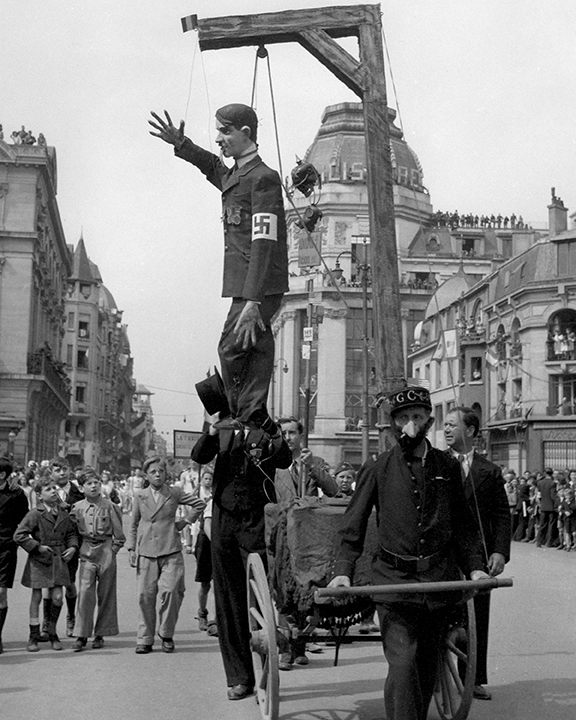
The citizens of Rheims, France, commemorate victory with a parade Rheims, France May 1945 The city of Rheims, France, celebrates Allied victory with a Victory Parade. U.S. Army Tech Sergeant Al Meserlin captured the celebration in this photo. The citizens of Rheims are seen standing everywhere, even on the tops of the tallest buildings in the city.
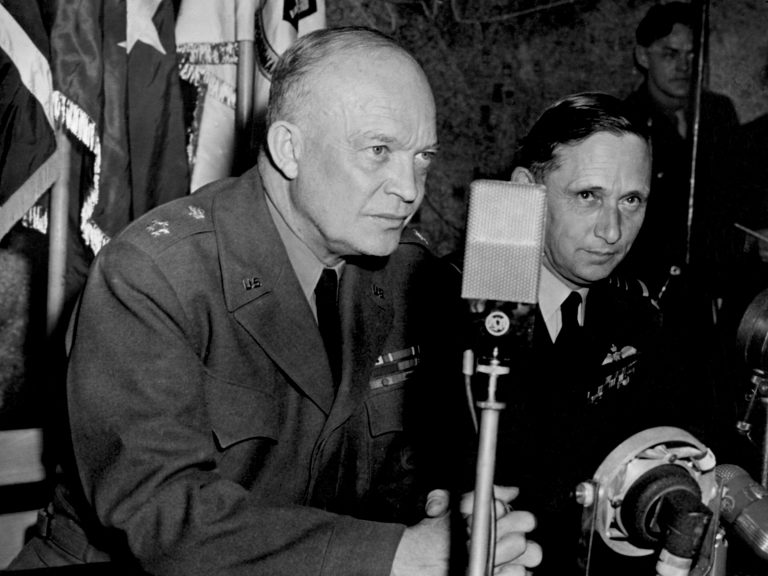
General Dwight D. Eisenhower, Supreme Allied Commander, broadcasts a victory speech War Room Supreme Headquarters Allied Expeditionary Force Forward Rheims, France May 7, 1945 (0400 hours) General of the Army Dwight D. Eisenhower, Supreme Allied Commander, with British Air Chief Marshal Sir Arthur Tedder, Deputy Supreme Allied Commander, beside him, makes a “victory speech” in the SHAEF war room. Eisenhower spoke briefly without using prepared notes and announced the end of the war in Europe.
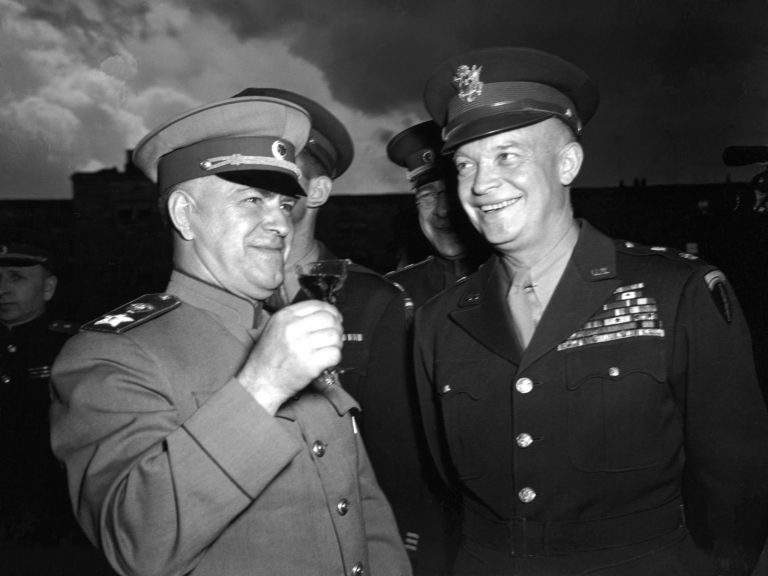
General Eisenhower and Soviet Field Marshal Georgi Zhukov Frankfurt am Main, Germany June 10, 1945 Soviet Field Marshal Georgi Zhukov, left, toasts General Dwight Eisenhower after presenting Ike with the Soviet Union’s highest decoration, the Order of Victory. The presentation was made at Ike’s new headquarters in Frankfurt am Main, Germany, on June 10, 1945.
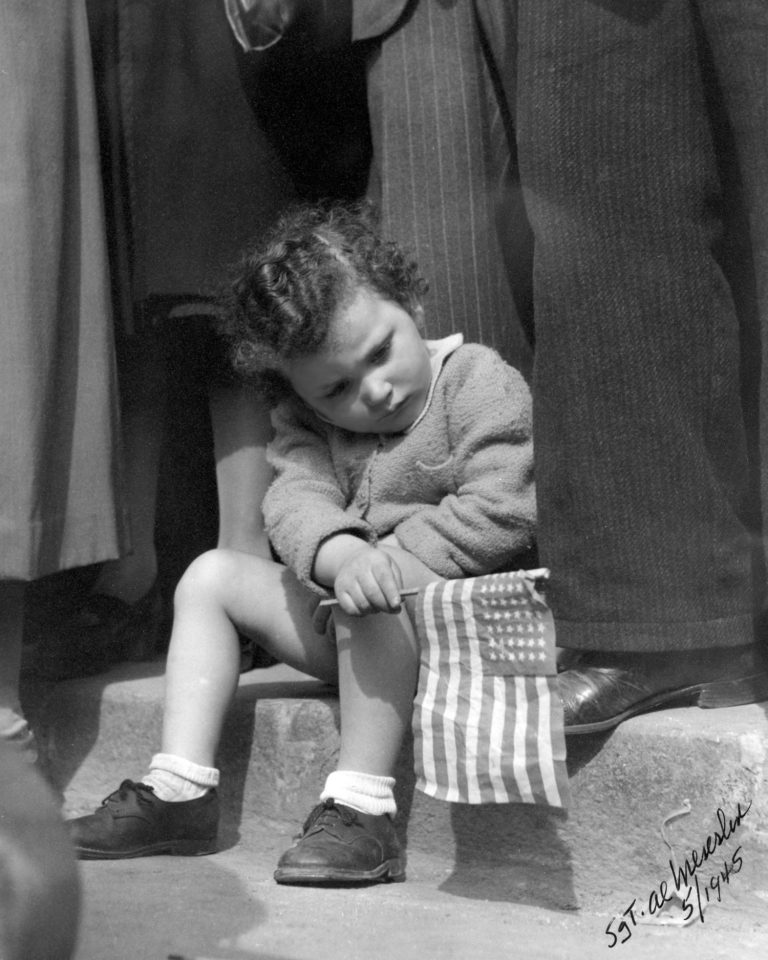
French child at the Rheims Victory Parade Rheims, France May 1945 An endearing photo of a French child attending the Rheims Victory Parade, this was one of the last photos taken in Europe by U.S. Army Technical Sergeant 5th Grade Al Meserlin, personal wartime photographer to U.S. General Dwight D. Eisenhower, Supreme Allied Commander, Europe.
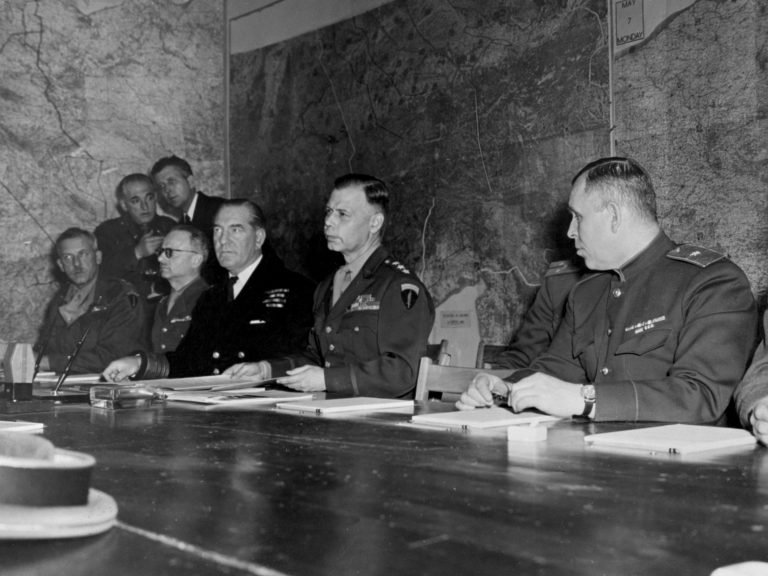
Allied representatives seated at the surrender table War Room Supreme Headquarters Allied Expeditionary Force Forward Rheims, France May 7, 1945 (0200 hours) Presenting the unconditional surrender terms to the German delegation is U.S. Lieutenant General Walter Bedell Smith, Eisenhower’s Chief of Staff (center), flanked by, seated left to right, British Lieutenant General Frederick Morgan, SHAEF Deputy Chief of Staff; French Major General Francois Sevez, representative of General Alphonse Juin, French Chief of Staff; British Admiral Sir Harold M. Burrough, Commander, Allied Naval Expeditionary Forces; and Soviet Major General Ivan Susloparov, representative of the Soviet Chief of Staff.
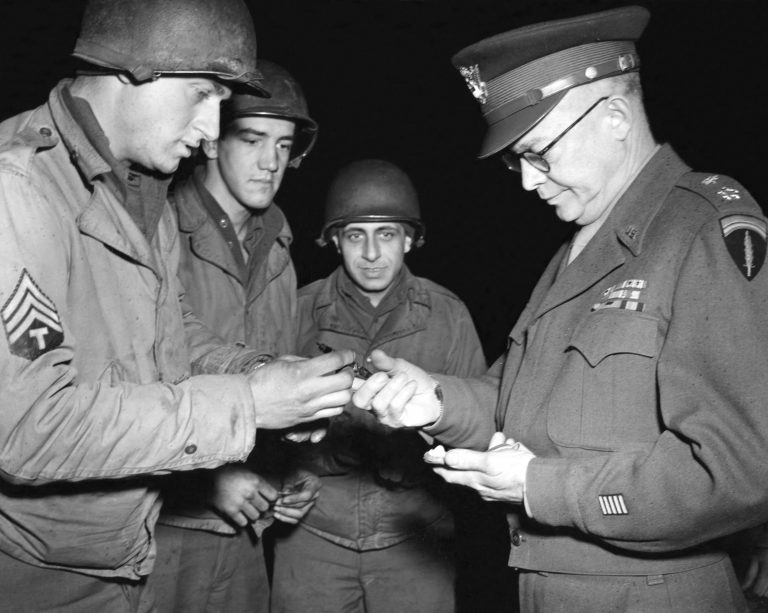
Meeting the troops - Bastogne, Belgium February 5, 1945 General Dwight Eisenhower, Supreme Allied Commander, signs an autograph for Technical Sergeant Kenneth McKeen of Long Beach, NY. Sergeant McKeen was a radio operator in an engineer unit. Ike stopped to visit the unit while looking over the Battle of the Bulge battlefield.
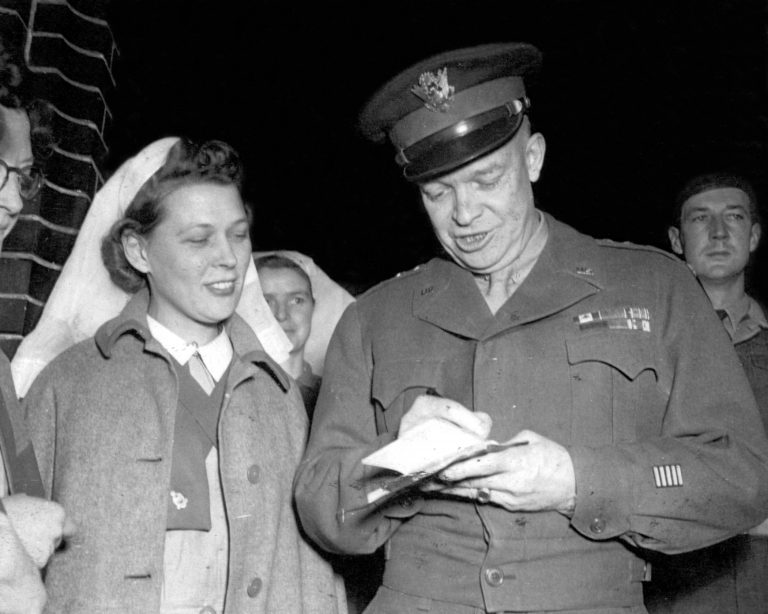
Visiting the troops 12th Evacuation Hospital Nancy, France November 15, 1944 General Eisenhower signs autographs for the staff of the 12th Evacuation Hospital in Nancy, France. Ike talked with the wounded and presented decorations and medals. He was accompanied during the visit by U.S. Lieutenant General George S. Patton, commander of the U.S. Third Army (not pictured).
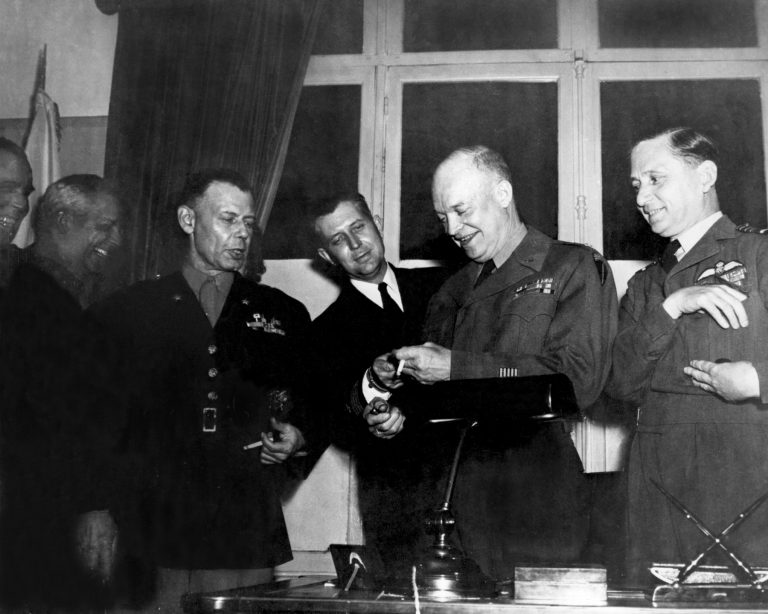
General Eisenhower shows the pens used to sign the unconditional surrender of Nazi Germany Eisenhower’s Office, SHAEF Headquarters Forward Rheims, France May 7, 1945 (0300 hours) After signing the unconditional surrender document, the German delegation was taken to General Eisenhower’s office, where he asked them if they fully understood the terms of the surrender and whether they were prepared to execute them. The Germans answered “yes,” bowed stiffly, and left the room. When they left, Ike asked Al Meserlin to take this photo as he flashed a “V” for Victory, using the surrender document pens. Pictured in the top photo, left to right, are British Lieutenant General Sir Frederick Morgan, SHAEF Deputy Chief of Staff; U.S. Lieutenant General Walter Bedell Smith, SHAEF Chief of Staff; British Lieutenant Kay Summersby, Ike’s official driver; U.S. Navy Captain Harry C. Butcher, Naval Aide to General Eisenhower; and British Air Chief Marshal Sir Arthur Tedder, Deputy Commander, SHAEF. The lower photo, actually taken first, is the picture that was released to the world’s press for publication. It includes, far left, Soviet General Ivan Susloparov, USSR representative (partially seen), but does not show Kay Summersby, who is standing behind General Smith. Captain Butcher is seen handing General Eisenhower the surrender pens.
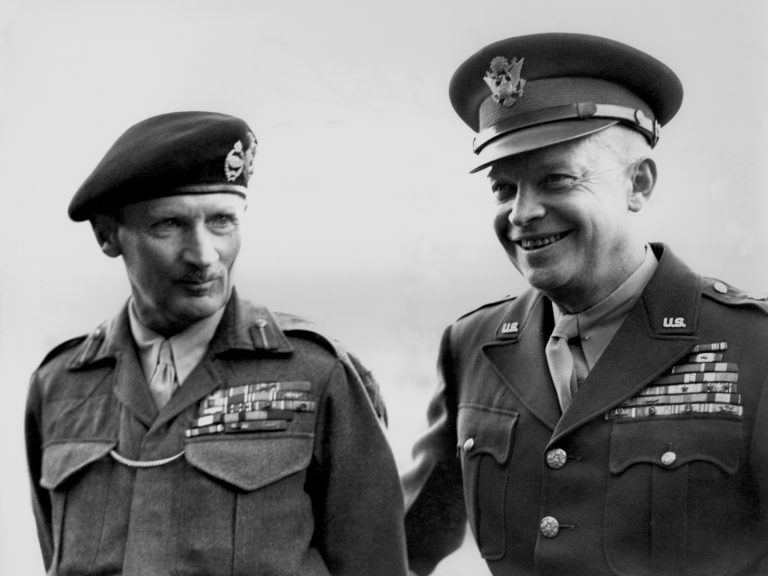
British Field Marshal Montgomery and Supreme Allied Commander, U.S. General Eisenhower Frankfurt am Main, Germany June 10, 1945 Sharing a moment together are British Field Marshal Sir Bernard Law Montgomery, left, and Supreme Allied Commander, U.S. General Dwight D. Eisenhower. Ike and Monty had each been awarded the Soviet Union’s highest decoration, the Order of Victory, at Ike’s headquarters in Frankfurt am Main, Germany on June 10, 1945.
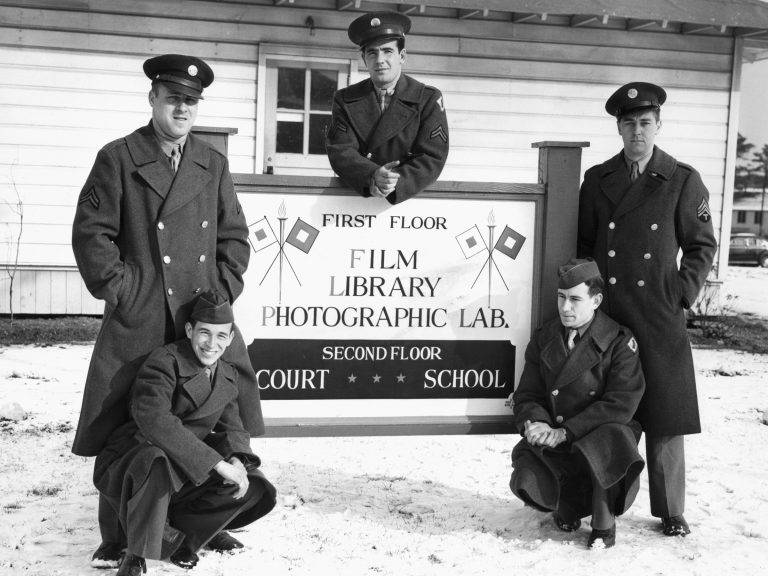
Camp Newspaper - Camp Edwards, Massachusetts Winter, 1942 Al Meserlin, kneeling at left, poses with buddies from the 3rd Signal Service Company, Camp Edwards, Massachusetts. In October 1942, Meserlin requested transfer to the Company to work as a photographer for the Camp Edwards newspaper.
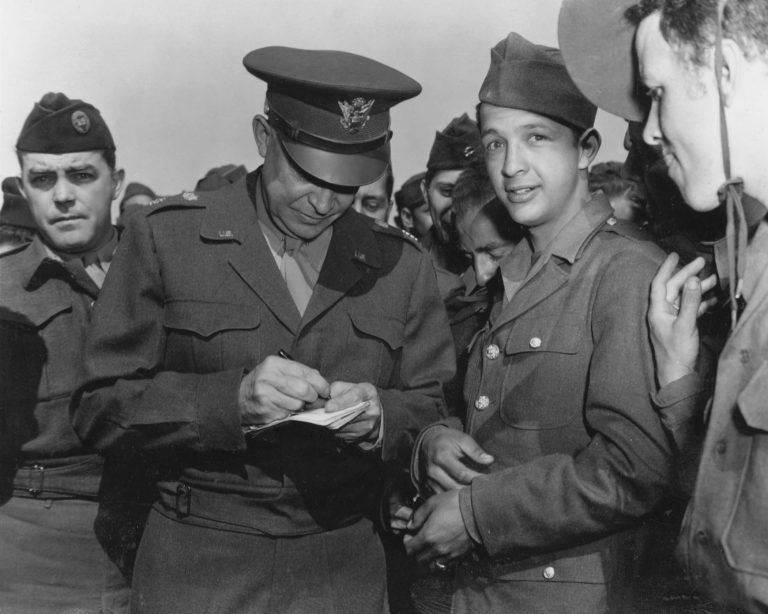
Visiting with the troops, March, 1945 General Dwight Eisenhower, Supreme Commander Allied Forces in Europe, signs his autograph for soldiers when on tour of the battlefront in March, 1945.
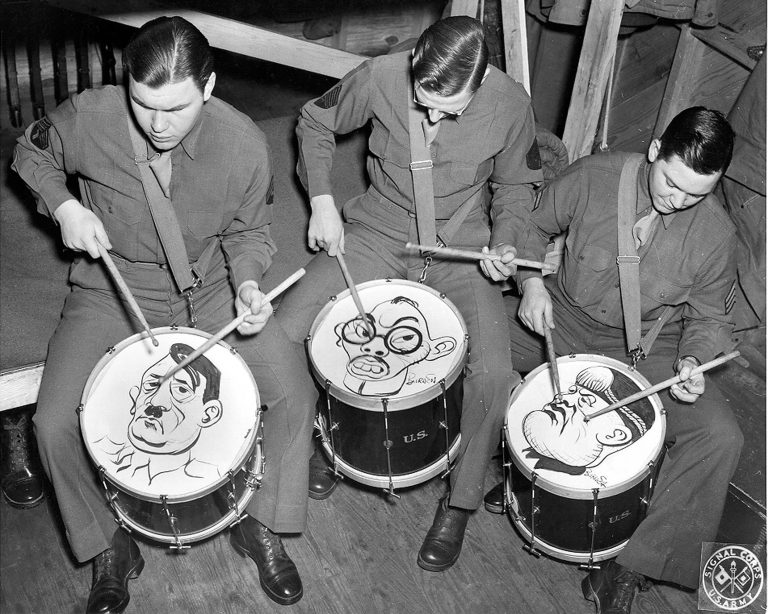
“Beating the enemy” - Fort musicians, Fort Sam Houston, Texas Spring 1943 Providing musical entertainment are three musicians playing drums at Fort Sam Houston. Pictured on the drum heads are, left to right, Reich Chancellor Adolf Hitler, leader of Nazi Germany; Prime Minister Hideki Tojo, leader of Imperial Japan; and Prime Minister Benito Mussolini, leader of Fascist Italy.
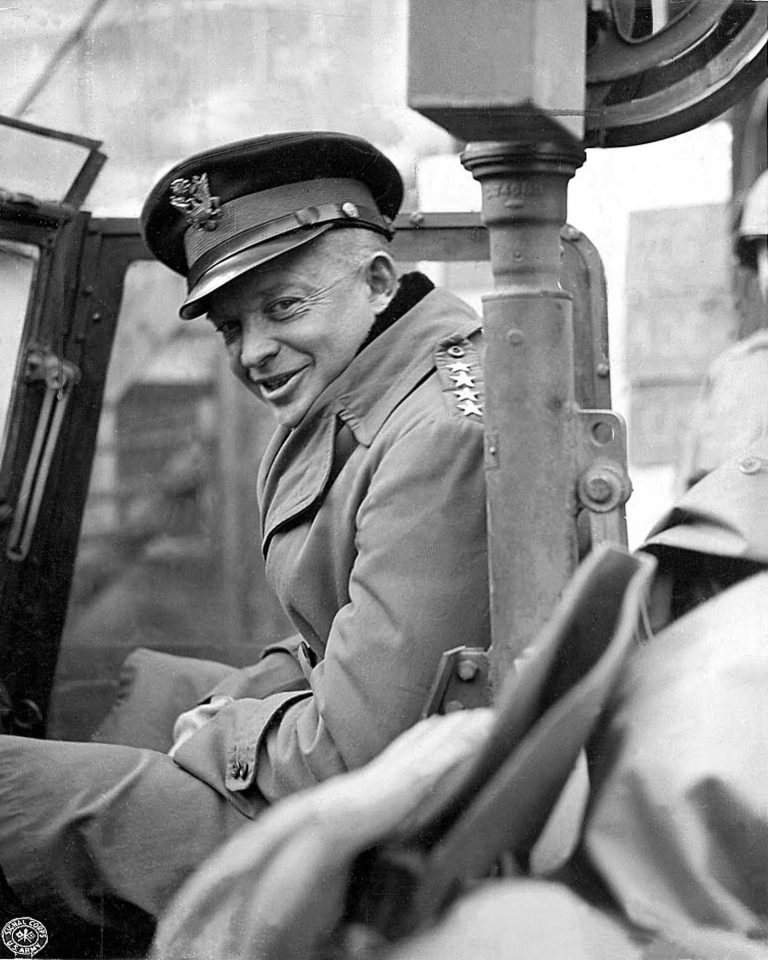
Eisenhower in his command jeep Versailles, France November 16, 1944 Photographed just prior to his leaving to visit the fighting front on November 16, 1944, this photo was Tech Sergeant Meserlin’s favorite photo of General Dwight D. Eisenhower, Supreme Commander, Allied Expeditionary Forces in Europe. Because of muddy conditions, Ike switched from his staff car to a jeep to tour the front so he could better navigate the roads.
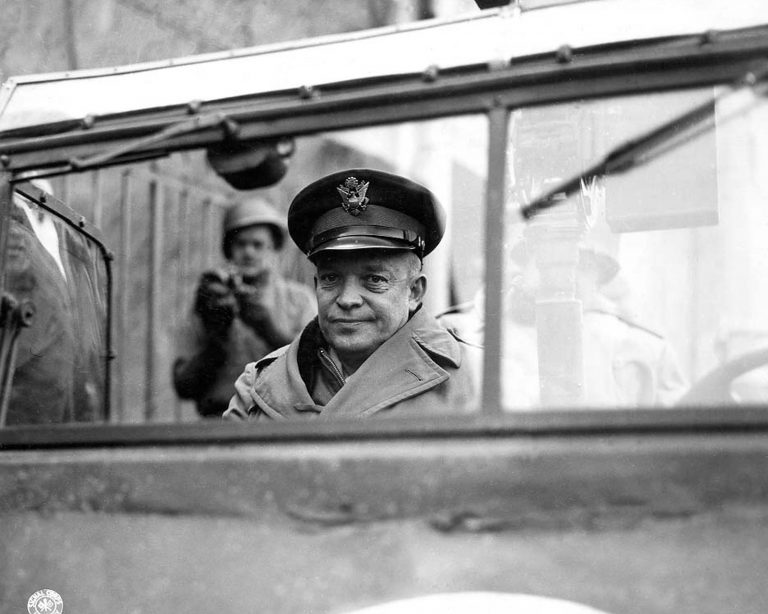
Ike sets out to visit the fighting front Versailles, France November 16, 1944 General Eisenhower, leaving his closed staff car behind because of muddy road conditions, boards a jeep to visit the fighting front. Behind Ike is U.S. Army cameraman Jack Howell who took movies of Ike while Al Meserlin took still photos. Meserlin and Howell worked as a team.
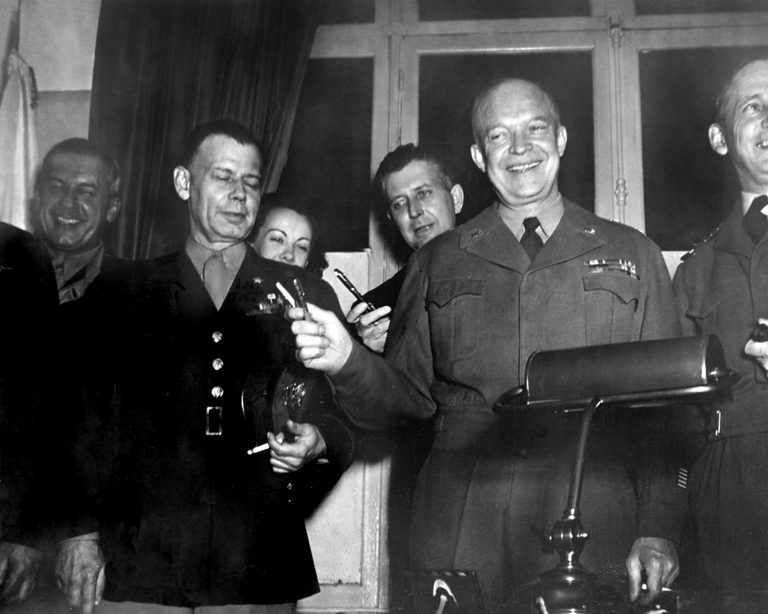
After signing the unconditional surrender document, the German delegation was taken to General Eisenhower’s office, where he asked them if they fully understood the terms of the surrender and whether they were prepared to execute them. The Germans answered “yes,” bowed stiffly, and left the room. When they left, Ike asked Al Meserlin to take this photo as he flashed a “V” for Victory, using the surrender document pens. Pictured in the top photo, left to right, are British Lieutenant General Sir Frederick Morgan, SHAEF Deputy Chief of Staff; U.S. Lieutenant General Walter Bedell Smith, SHAEF Chief of Staff; British Lieutenant Kay Summersby, Ike’s official driver; U.S. Navy Captain Harry C. Butcher, Naval Aide to General Eisenhower; and British Air Chief Marshal Sir Arthur Tedder, Deputy Commander, SHAEF. The lower photo, actually taken first, is the picture that was released to the world’s press for publication. It includes, far left, Soviet General Ivan Susloparov, USSR representative (partially seen), but does not show Kay Summersby, who is standing behind General Smith. Captain Butcher is seen handing General Eisenhower the surrender pens.
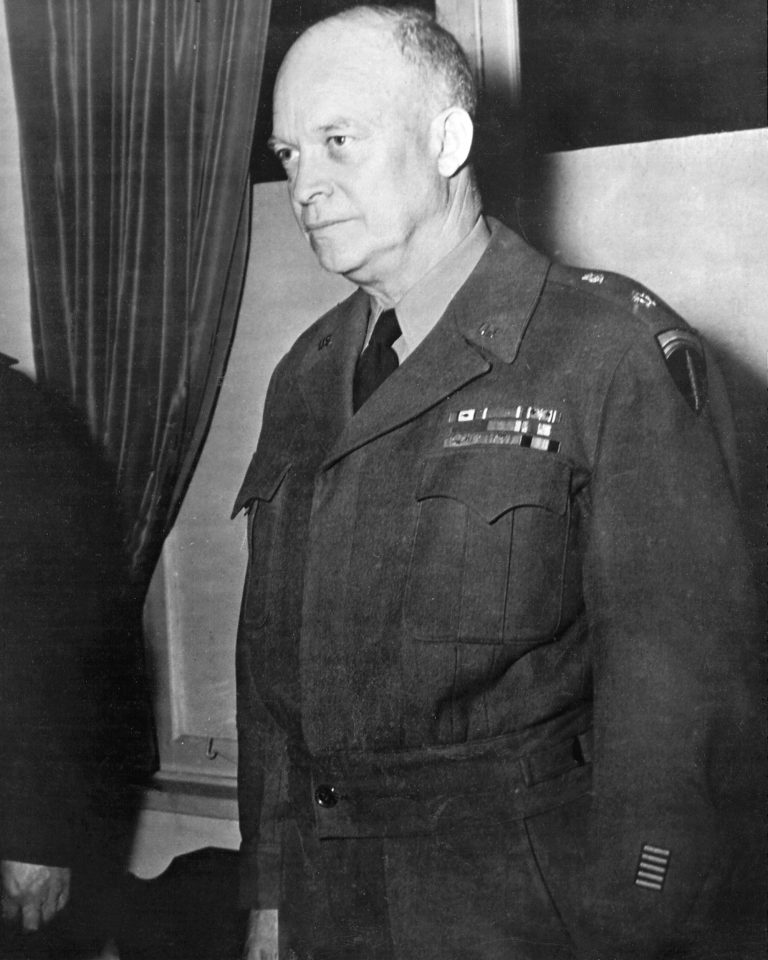
General Dwight D. Eisenhower, Supreme Allied Commander, awaits word of the surrender Supreme Headquarters Allied Expeditionary Force Forward Rheims, France May 7, 1945 General Eisenhower, Supreme Commander, Allied Forces, waits in his office at SHAEF headquarters for the Germans to surrender. He delegated to his Chief of Staff, U.S. Lieutenant General Walter Bedel Smith, the responsibility of conducting the unconditional surrender of Nazi Germany to the Allies. Ike would only see the German delegation after they had surrendered.
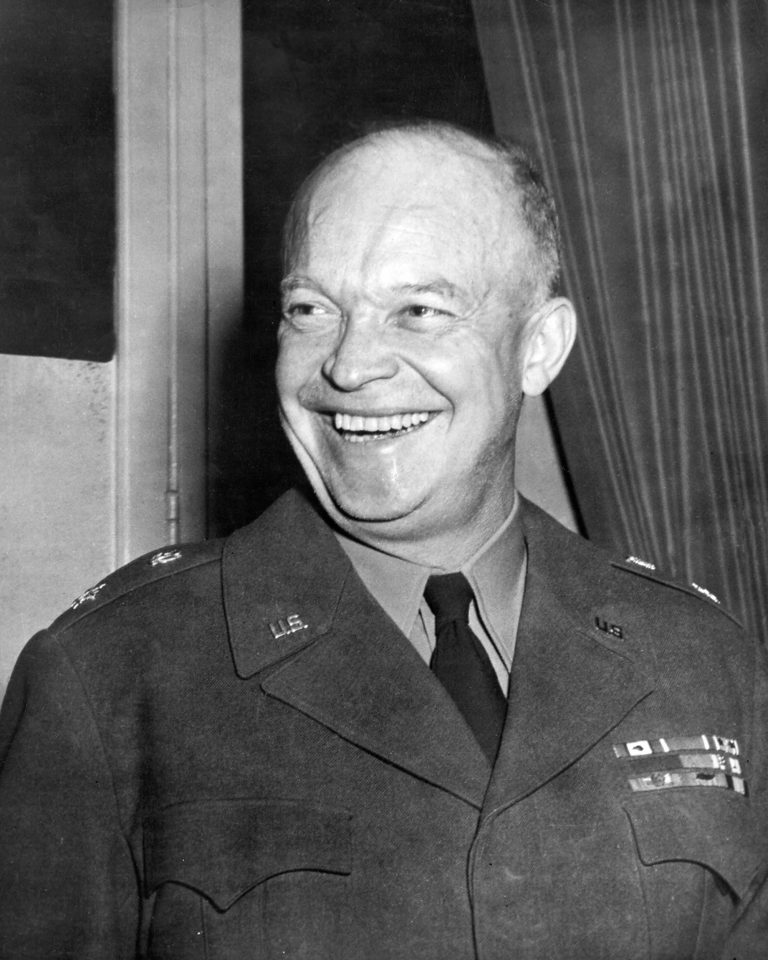
General Eisenhower reflecting the Allied mood after Nazi Germany’s unconditional surrender Supreme Headquarters Allied Expeditionary Force Forward Rheims, France May 7, 1945 (0430 hours) A picture worth a thousand words – Supreme Allied Commander U.S. General Dwight D. Eisenhower after the surrender proceedings at Rheims, France. He sent the Combined Chiefs of Staff the simple message, “The mission of this Allied Force was fulfilled at 0241 local time, May 7, 1945.”
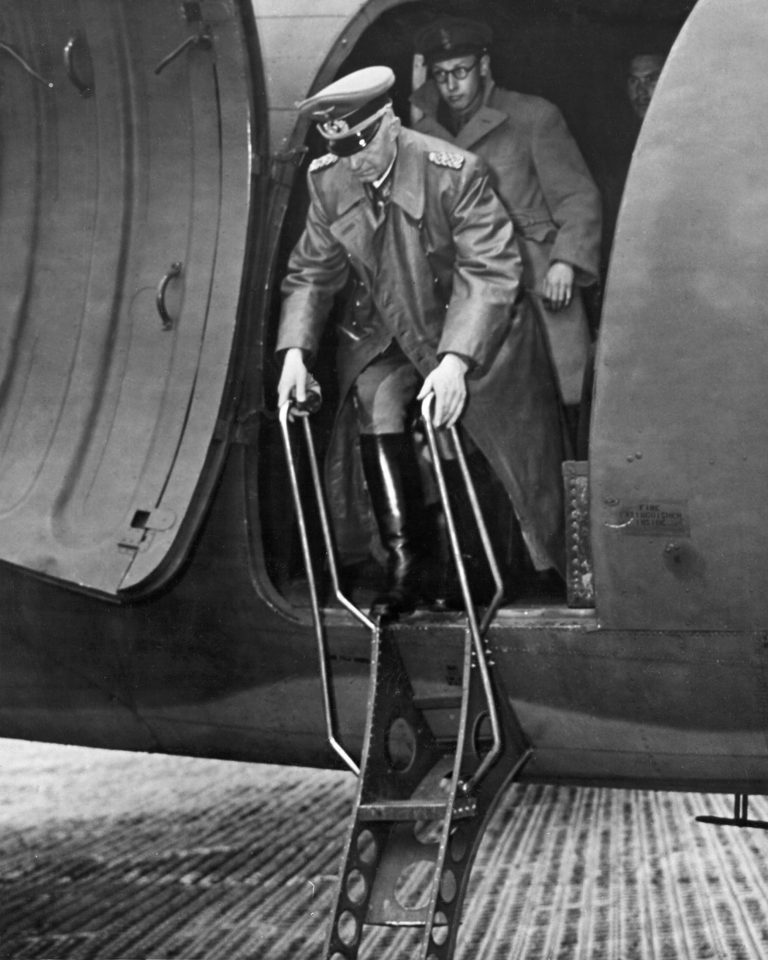
Colonel General Alfred Jodl, Chief of Staff, German Army, comes to Rheims, France - May 6, 1945 (1650 hours) Colonel General Alfred Jodl, Chief of Staff, German Army, arrives at Rheims Airport, Rheims, France, the afternoon of May 6, 1945. General Jodl had been authorized by his government to sign the unconditional surrender document, surrendering Nazi Germany to the Allies.
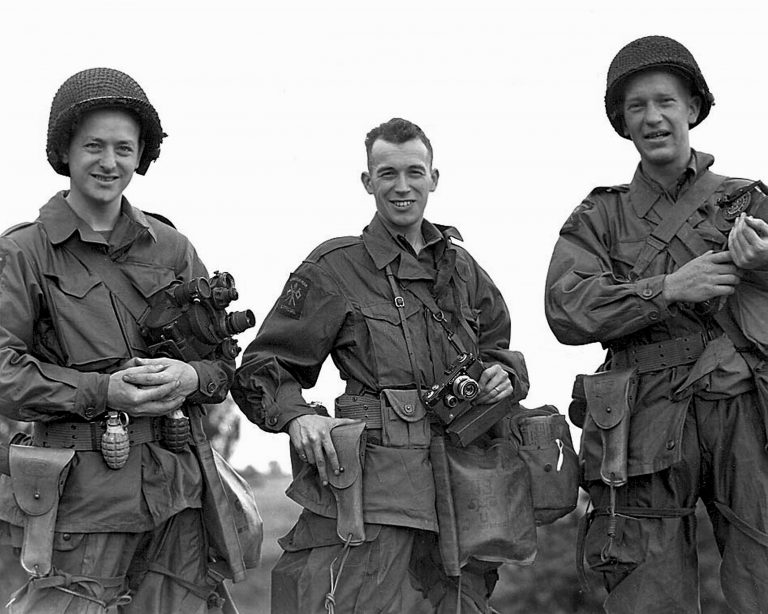
Operation MARKET-GARDEN, the Allied airborne assault on the Lower Rhine September 17, 1944 Assigned to photograph U.S. airborne forces participating in Operation MARKET-GARDEN, Al Meserlin, center, is pictured with two buddies, all carrying parachutes and combat gear. Meserlin was pulled from the assignment just before the airborne units took off to carry out the operation in eastern Holland.
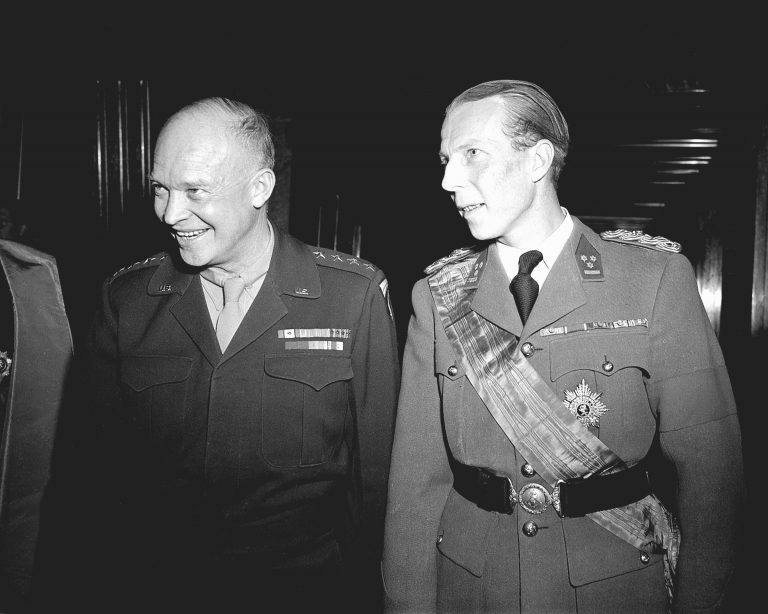
General Eisenhower meets Prince Charles of Belgium Brussels, Belgium November 9, 1944 Prince Charles of Belgium, right, greets General Eisenhower in Brussels, upon Ike’s visit to Belgium’s capital city on November 9, 1944. General Eisenhower thereafter addressed the Belgian Deputies and Senate in a joint session.
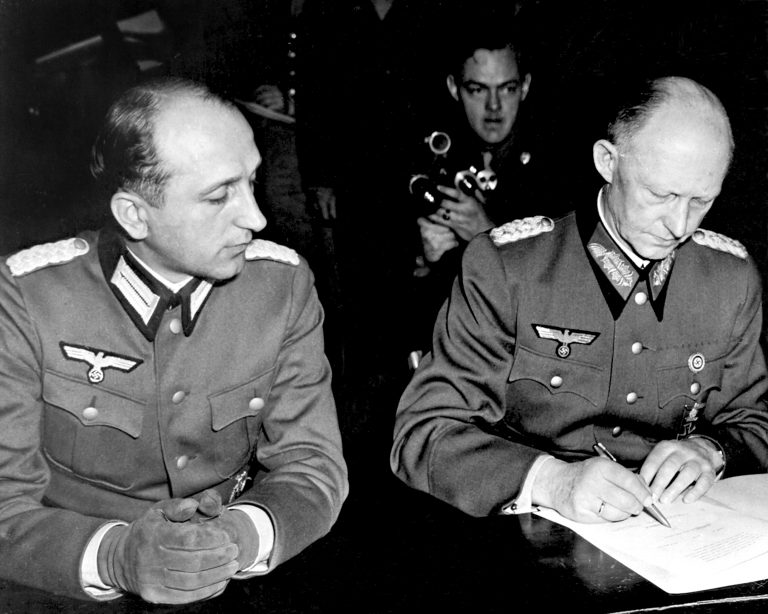
German Colonel General Alfred Jodl signs the unconditional surrender document War Room Supreme Headquarters Allied Expeditionary Force Forward Rheims, France May 7, 1945 (0241 hours) Major Wilhelm Oxenius, aide to Colonel General Alfred Jodl, Chief of Staff of the German Army, watches as General Jodl signs the document surrendering Nazi Germany unconditionally to the Allies. U.S. Army cameraman Jack Howell is seen in the rear filming the event while U.S. Army photographer Al Meserlin captures the historic moment.
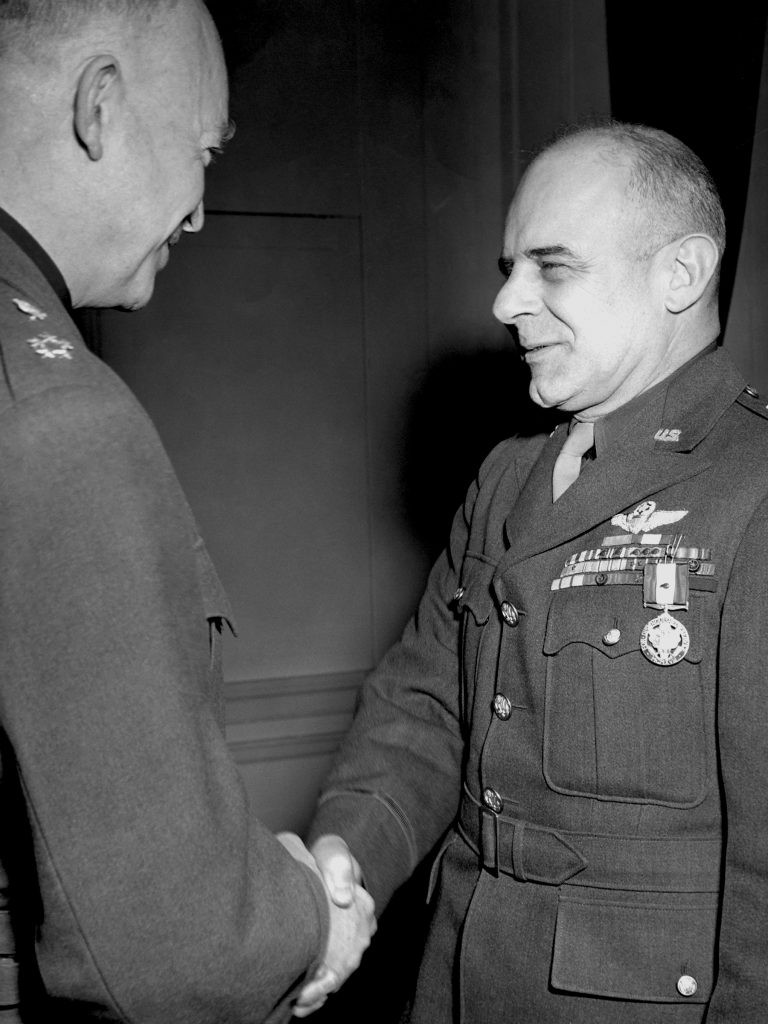
General Eisenhower awards USAAF General Jimmy Doolittle for meritorious service Supreme Headquarters Allied Expeditionary Forces Versailles, France January 25, 1945 General Eisenhower shakes hands with U.S. Army Air Force General James Doolittle, commander 8th U.S. Air Force, after awarding him an Oak Leaf Cluster to his Distinguished Service Medal for exceptional meritorious service. Ike is seen wearing his new rank of 5 stars, having been promoted in December,1944, to General of the Army.
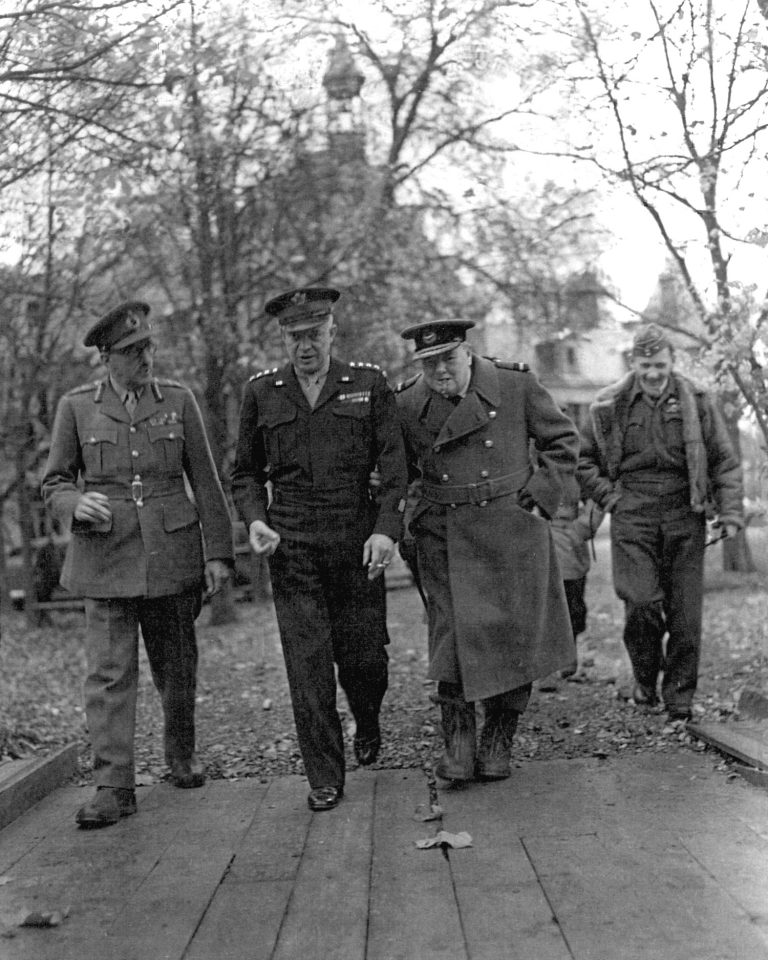
Eisenhower walking with British Prime Minister Winston Churchill and party Rheims, France November 14, 1944 Seen touring General Eisenhower’s headquarters camp near Rheims, France are (left to right) British Field Marshal Sir Allan Brooke, Chief of the Imperial General Staff; General Eisenhower; British Prime Minister Winston Churchill; and British Chief Air Marshal Sir Arthur Tedder, Deputy Commander, Allied Forces Europe. Ike located the forward command site of Supreme Headquarters, Allied Forces Europe, in Rheims, France.
Diversity Statement: Brookdale Community College fosters an environment of inclusion and belonging. We promote a safe and open culture, encourage dialogue respecting diverse perspectives informed by credible sources, and uphold the virtues of civil discourse. We celebrate all identities with the understanding that ultimately, diversity, equity, and inclusion cultivate belonging and make us a stronger Brookdale community.
